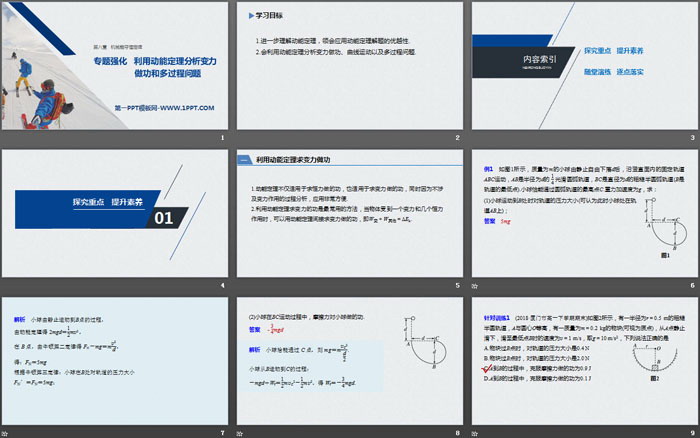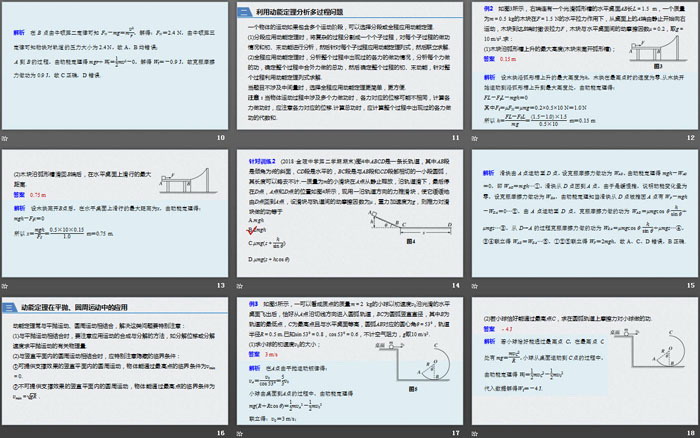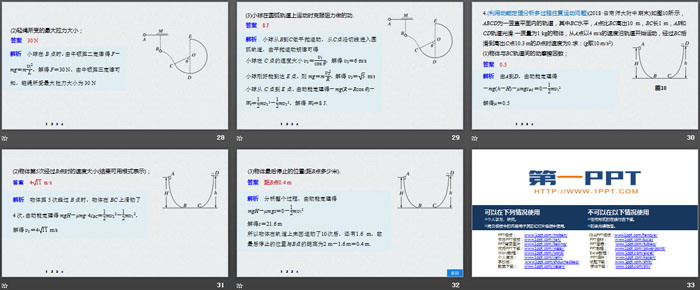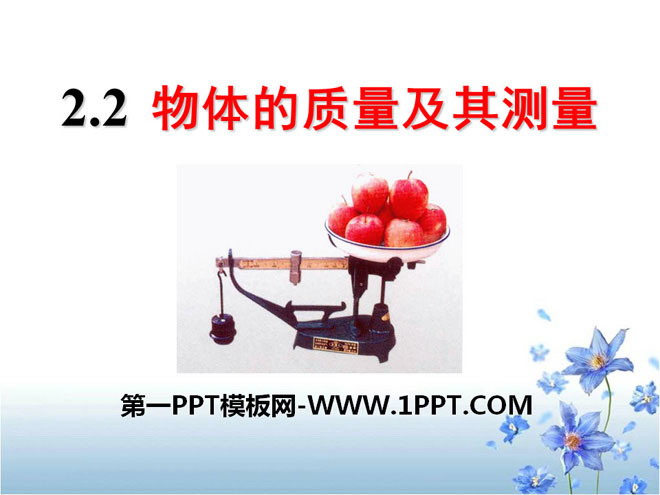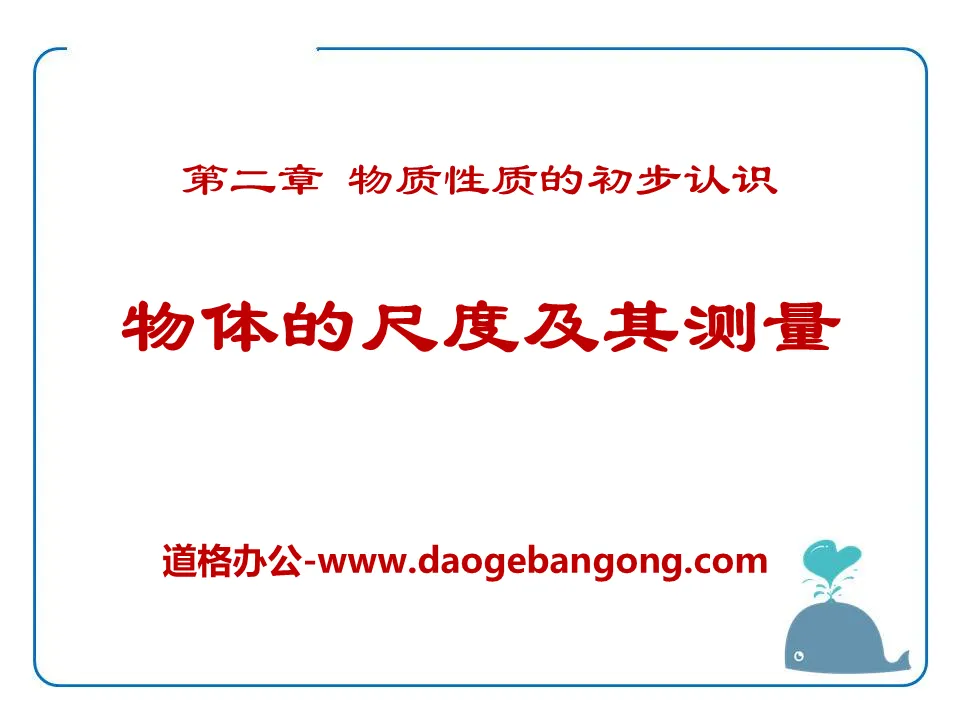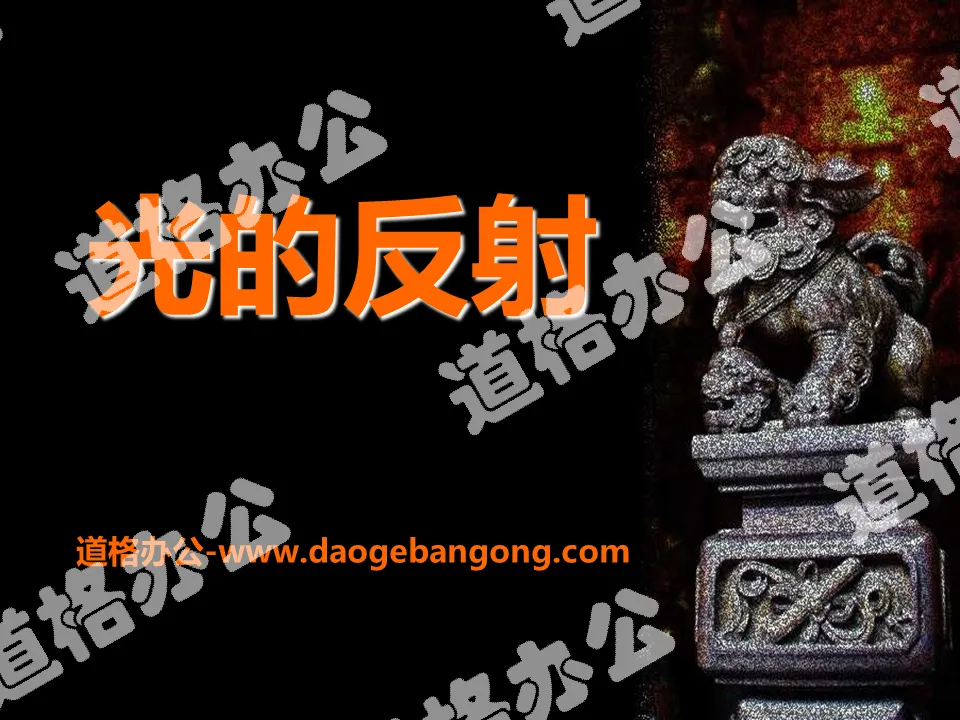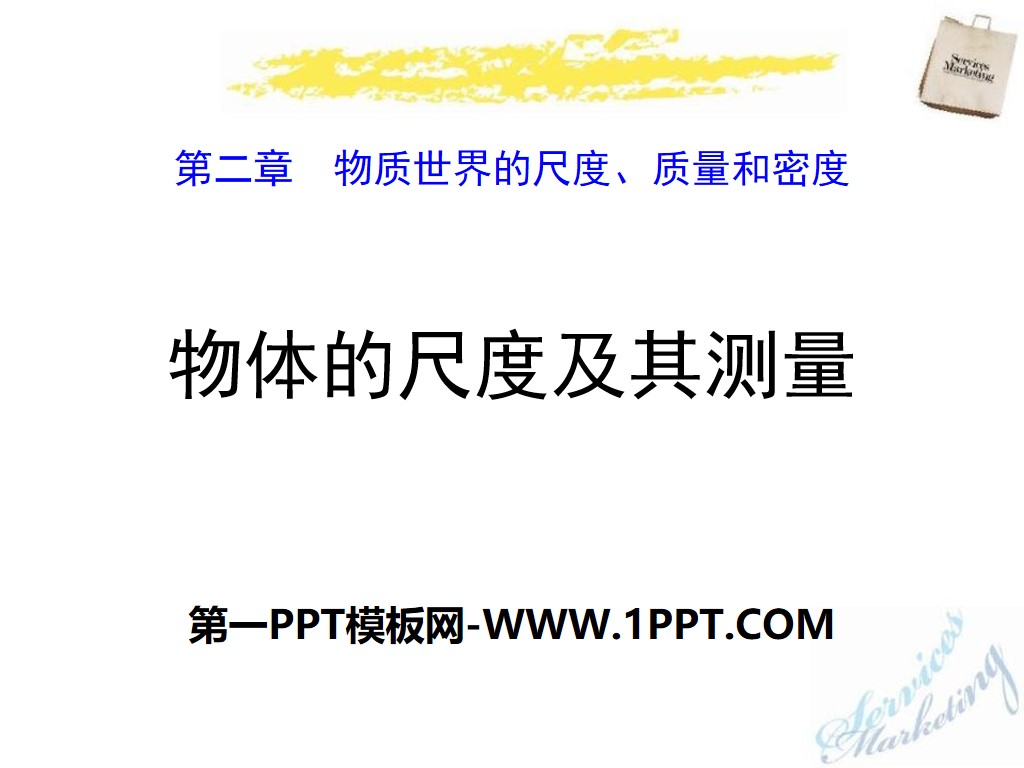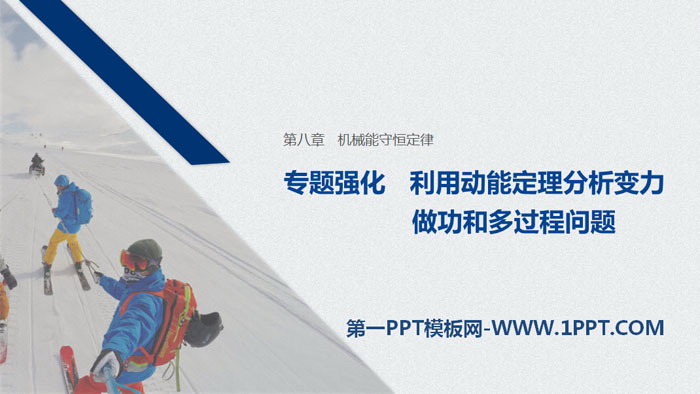
| Category | Format | Size |
|---|---|---|
| People's Education Press High School Physics Compulsory Course II | pptx | 6 MB |
Description
"Special Topic Strengthening: Using Kinetic Energy Theorem to Analyze Variable Force, Work and Multi-Process Problems" PPT Excellent Courseware on the Law of Conservation of Mechanical Energy
Part One: Learning Objectives
1. Further understand the kinetic energy theorem and appreciate the advantages of using the kinetic energy theorem to solve problems.
2. Be able to use the kinetic energy theorem to analyze work by variable force, curved motion and multi-process problems.
Use the kinetic energy theorem to analyze variable force work and multi-process problems PPT, part 2 content: 01 Exploring key points to improve literacy
1. Use the kinetic energy theorem to find the work done by a variable force
1. The kinetic energy theorem is not only suitable for finding the work done by a constant force, but also for finding the work done by a variable force. At the same time, because it does not involve process analysis of the action of a variable force, it is very convenient to apply.
2. Using the kinetic energy theorem to find the work of a variable force is the most commonly used method. When an object is acted upon by one variable force and several constant forces, the kinetic energy theorem can be used to indirectly find the work done by the variable force, that is, W change + W others = ΔEk.
Example 1 As shown in Figure 1, a small ball of mass m moves from rest to free fall d along a fixed orbit ABC in the vertical plane. AB is a smooth arc orbit with a radius d, and BC is a rough circular orbit with a diameter d. Semi-circular arc orbit (B is the lowest point of the orbit). The ball can just pass through the highest point C of the arc orbit. The acceleration due to gravity is g. Find:
(1) The amount of pressure the ball exerts on the track when it moves to position B (it can be considered that the ball is on track AB at this time);
(2) The work done by the friction force on the ball during BC motion.
For training 1 (2018·Xiamen City, the end of the first semester of high school) as shown in Figure 2, there is a rough semicircular orbit with a radius r = 0.5 m, A is the same height as the center O, and there is a block with a mass m = 0.2 kg (can regarded as a particle), slide down from point A at rest, and the speed when sliding to the lowest point B is v=1 m/s, take g=10 m/s2, the following statement is correct:
A. When the block passes point B, the pressure on the track is 0.4 N
B. When the block passes point B, the pressure on the track is 2.0 N
C. In the process from A to B, the work done to overcome the friction force is 0.9 J
D. In the process from A to B, the work done to overcome the friction force is 0.1 J
2. Use kinetic energy theorem to analyze multi-process problems
If the motion of an object includes multiple motion stages, you can choose to apply the kinetic energy theorem segmentally or throughout the entire process.
(1) When applying the kinetic energy theorem in sections, divide the complex process into a sub-process, analyze the work and initial and final kinetic energy of each sub-process, and then apply the kinetic energy theorem formula for each sub-process, and then solve it simultaneously .
(2) When applying the kinetic energy theorem throughout the process, analyze the work done by each force that occurred in the entire process, analyze the work done by each force, determine the total work done by the combined external forces in the entire process, and then determine the initial and final kinetic energy of the entire process , use the kinetic energy theorem to solve the entire process.
When the question does not involve intermediate quantities, it is simpler and more convenient to choose to apply the kinetic energy theorem throughout the process.
Note: When multiple forces are involved in the work of an object, the displacements corresponding to each force may be different. When calculating the work of each force, attention should be paid to the displacements corresponding to each force. When calculating the total work, the displacements that occurred in the entire process should be calculated. The algebraic sum of the work done by each force.
Example 2 As shown in Figure 3, the length of the horizontal tabletop AB with a smooth arc groove connected to the right end is L=1.5 m. A wooden block with a mass m=0.5 kg is pulled from the tabletop under the action of a horizontal pulling force of F=1.5 N. The A end of the block starts to move to the right from rest. When the wooden block reaches the B end, the pulling force F is removed. The kinetic friction factor μ between the wooden block and the horizontal tabletop is 0.2. Take g=10 m/s2. Find:
(1) The maximum height of the wooden block rising along the arc-shaped groove (the wooden block does not leave the arc-shaped groove);
(2) The maximum distance the wooden block slides on the horizontal table after sliding back to end B along the arc groove.
3. Application of kinetic energy theorem in horizontal throw and circular motion
The kinetic energy theorem is often combined with flat throw motion and circular motion. Special attention should be paid to solving such problems:
(1) When combined with the flat throwing motion, attention should be paid to the application of the synthesis and decomposition methods of motion, such as decomposing the displacement or decomposing the velocity to obtain the relevant physical quantities of the flat throwing motion.
(2) When combined with circular motion in the vertical plane, special attention should be paid to the hidden critical conditions:
① Circular motion in a vertical plane that can provide support effect. The critical condition for an object to pass the highest point is vmin=0.
② Circular motion in a vertical plane that cannot provide support effect. The critical condition for an object to pass the highest point is vmin=√gR.
Example 3 As shown in Figure 5, a small ball with mass m = 2 kg that can be regarded as a particle flies out along a smooth horizontal table with an initial velocity v0, and enters a circular arc orbit along the tangent direction from point A. BC is a circle The vertical diameter of the arc, where B is the lowest point of the track, C is the highest point and is the same height as the horizontal tabletop, the central angle θ corresponding to the arc AB = 53°, and the orbit radius R = 0.5 m. It is known that sin 53° = 0.8 , cos 53°=0.6, regardless of air resistance, g is 10 m/s2.
(1) Find the initial velocity v0 of the ball;
(2) If the ball can just pass the highest point C, find the work done on the ball by the friction force on the arc orbit.
4. Application of kinetic energy theorem in multi-process reciprocating motion
Example 4 The slide in a certain playground can be simplified as an ABCD track in the vertical plane as shown in Figure 6. AB is an inclined track with a length L = 6 m and an inclination angle α = 37°, BC is a horizontal track, and CD is a radius R = A 15 m arc orbit with a central angle β = 37°. The AB segment of the orbit is rough and the remaining segments are smooth. A child (can be regarded as a particle) slides down from point A with an initial velocity v0 = 2 m/s and moves along the orbit. The speed when reaching point D is exactly zero (not counting the energy loss when passing point B). It is known that the child’s mass m=30 kg, sin 37°=0.6, cos 37°=0.8, take g=10 m/s2 , regardless of air resistance, assuming that the maximum static friction force is equal to the sliding friction force, find:
(1) The pressure exerted on the arc track when the child passes point C of the arc track for the first time;
(2) The dynamic friction factor between the child and segment AB;
In conclusion
1. During the reciprocating motion with frictional force doing work, pay attention to the difference between the work done by the two forces:
(1) The work done by gravity is only related to the initial and final positions and has nothing to do with the path;
(2) The work done by sliding friction (or all resistance) is related to the path. The work done to overcome friction (or all resistance) is W = Ffs (s is the distance).
2. Due to the superiority of the kinetic energy theorem in solving problems, the kinetic energy theorem is generally used to find the distance in multi-process reciprocating motion problems.
Use the kinetic energy theorem to analyze variable force work and multi-process problems PPT, the third part of the content: 02 in-class drill, implementation point by point
1. (Use the kinetic energy theorem to find the work done by a variable force) As shown in Figure 7, a horizontal turntable with a radius R and a slide block with a mass m placed on the edge of the turntable. It is known that the kinetic friction factor between the slide block and the turntable is μ, and the maximum static friction force is equal to the sliding friction force, and the gravity acceleration is g. If the rotation speed of the turntable gradually increases from zero, when the slide block happens to slide relative to the turntable, the work done by the turntable on the slide block is
A.μmgR B.2πmgR
C.2μmgR D.0
2. (Use the kinetic energy theorem to analyze multi-process problems) (2018·Hebi City, the end of the first semester of high school) As shown in Figure 8, AB is a quarter arc orbit, BC is a horizontal straight orbit, and the radius of the arc is R. The length of BC is also R. An object with mass m has a kinetic friction coefficient of μ between the two orbits. It starts sliding from rest at the top of the orbit A and stops at C. Regardless of air resistance, the acceleration due to gravity is g. , then the work done by the object to overcome the friction force in segment AB is
3. (Application of kinetic energy theorem in horizontal throw and circular motion) (2019·Wenzhou New Power League first semester midterm) As shown in Figure 9, the upper end of a long L = 0.45 m, inextensible light rope is suspended from M point, the lower end is tied to a small ball with mass m = 1.0 kg. CDE is a vertically fixed arc-shaped orbit with a radius R = 0.50 m. The angle between OC and the vertical direction is θ = 60°. Now pull the small ball When it reaches point A (keep the rope straight and horizontal), it is released from rest. When it passes point B, the rope is broken. After the ball is thrown flatly, it enters the orbit along the tangent direction from point C of the arc orbit, just enough to reach the circle. At the highest point E of the arc orbit, the gravity acceleration g is 10 m/s2. Find:
(1) The speed of the ball when it reaches point B;
(2) The maximum pulling force on the light rope;
(3) The work done by the ball against the resistance when moving on the arc orbit.
Keywords: PPT courseware for high school physics compulsory course 2 from the People's Education Press is free to download, using the kinetic energy theorem to analyze variable force work and multi-process problems PPT download, law of conservation of mechanical energy PPT download, .PPT format;
For more information about the PPT courseware "The Law of Conservation of Mechanical Energy Uses the Kinetic Energy Theorem to Analyze Work with Variable Force and Multi-Process Problems", please click on the PPT tag of "The Law of Conservation of Mechanical Energy PPT Uses the Kinetic Energy Theorem to Analyze Work with Variable Force and Multi-Process Problems".
File Info
Update Time: 2024-08-02
This template belongs to Physics courseware People's Education Press High School Physics Compulsory Course II industry PPT template
"Special Topic Strengthening: Using Kinetic Energy Theorem to Analyze Variable Force, Work and Multi-Process Problems" PPT Excellent Courseware on the Law of Conservation of Mechanical Energy Simple campus recruitment activity planning plan summary enterprise and institution recruitment publicity lecture PPT template is a general PPT template for business post competition provided by the manuscript PPT, simple campus recruitment activity planning plan summary enterprise and institution recruitment promotion Lecture PPT template, you can edit and modify the text and pictures in the source file by downloading the source file. If you want more exquisite business PPT templates, you can come to grid resource. Doug resource PPT, massive PPT template slide material download, we only make high-quality PPT templates!
Tips: If you open the template and feel that it is not suitable for all your needs, you can search for related content "Special Topic Strengthening: Using Kinetic Energy Theorem to Analyze Variable Force, Work and Multi-Process Problems" PPT Excellent Courseware on the Law of Conservation of Mechanical Energy is enough.
How to use the Windows system template
Directly decompress the file and use it with office or wps
How to use the Mac system template
Directly decompress the file and use it Office or wps can be used
Related reading
For more detailed PPT-related tutorials and font tutorials, you can view: Click to see
How to create a high-quality technological sense PPT? 4 ways to share the bottom of the box
Notice
Do not download in WeChat, Zhihu, QQ, built-in browsers, please use mobile browsers to download! If you are a mobile phone user, please download it on your computer!
1. The manuscript PPT is only for study and reference, please delete it 24 hours after downloading.
2. If the resource involves your legitimate rights and interests, delete it immediately.
3. Contact information: service@daogebangong.com
"Special Topic Strengthening: Using Kinetic Energy Theorem to Analyze Variable Force, Work and Multi-Process Problems" PPT Excellent Courseware on the Law of Conservation of Mechanical Energy, due to usage restrictions, it is only for personal study and reference use. For commercial use, please go to the relevant official website for authorization.
(Personal non-commercial use refers to the use of this font to complete the display of personal works, including but not limited to the design of personal papers, resumes, etc.)
Preview

